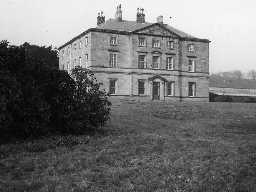Chapel at Close House (Heddon-on-the-Wall)
NZ 1272 6586 Close House [T.I.]. (1)
The date of the foundation of the chantry in Close House is not known. In 1313 the Bishop of Durham ordered an enquiry into the chantry of the Close near Whitechester. It was worth 60/- a year. In 1414 John Coldingham was presented by the crown 'to the chantry of Heddon-on-the-Wall, lately founded by Philip of Cranden', This was probably Close House chantry. In 1416 a jury found that in 1391 Nicholas Turpin had appropriated a chapel belonging to the chantry of the Close. After this the chantry seems to have been used as a private chapel, and was suppressed at the Reformation. Services were held there in the 18th century. The old chapel was pulled down to make room for the present Close House in 1779. (2)
The present owner of Close House was not available. There are no remains of a Chapel visible at the house. (3)
References to 'it was formerly a chapel' by Mackenzie in 1825 may refer to the ecclesiastical status of the township rather than saying the house was a chapel. (4)
A report on Close House is more confirmed in its thoughts that there was a chapel at Close House. (5)
An archaeological watching brief was undertaken at Close House by Alan Williams Archaeology between November 2014 and September 2015. The watching brief was carried out intermittently during extensive groundworks around the western wide of the house and immediate associated ranges. The results indicated that this area had been subject to extensive disturbance, truncation and terracing, much presumably during the construction of the standing late 18th century mansion. It was concluded that while previous groundwork could have removed evidence of earlier structures, the absence of any early artefacts make it more likely that earlier structures were located in another location. (6)
Additional references. (7)
The date of the foundation of the chantry in Close House is not known. In 1313 the Bishop of Durham ordered an enquiry into the chantry of the Close near Whitechester. It was worth 60/- a year. In 1414 John Coldingham was presented by the crown 'to the chantry of Heddon-on-the-Wall, lately founded by Philip of Cranden', This was probably Close House chantry. In 1416 a jury found that in 1391 Nicholas Turpin had appropriated a chapel belonging to the chantry of the Close. After this the chantry seems to have been used as a private chapel, and was suppressed at the Reformation. Services were held there in the 18th century. The old chapel was pulled down to make room for the present Close House in 1779. (2)
The present owner of Close House was not available. There are no remains of a Chapel visible at the house. (3)
References to 'it was formerly a chapel' by Mackenzie in 1825 may refer to the ecclesiastical status of the township rather than saying the house was a chapel. (4)
A report on Close House is more confirmed in its thoughts that there was a chapel at Close House. (5)
An archaeological watching brief was undertaken at Close House by Alan Williams Archaeology between November 2014 and September 2015. The watching brief was carried out intermittently during extensive groundworks around the western wide of the house and immediate associated ranges. The results indicated that this area had been subject to extensive disturbance, truncation and terracing, much presumably during the construction of the standing late 18th century mansion. It was concluded that while previous groundwork could have removed evidence of earlier structures, the absence of any early artefacts make it more likely that earlier structures were located in another location. (6)
Additional references. (7)
N10872
FIELD OBSERVATION, Ordnance Survey Archaeology Division Field Investigation 1951; J H Ostridge
HERITAGE ASSESSMENT, Close House, Heddon-on-the-Wall: an architectural-historical analysis 2014
WATCHING BRIEF, Land at Close House, Heddon 2015; Alan Williams Archaeology
HERITAGE ASSESSMENT, Close House, Heddon-on-the-Wall: an architectural-historical analysis 2014
WATCHING BRIEF, Land at Close House, Heddon 2015; Alan Williams Archaeology
Disclaimer -
Please note that this information has been compiled from a number of different sources. Durham County Council and Northumberland County Council can accept no responsibility for any inaccuracy contained therein. If you wish to use/copy any of the images, please ensure that you read the Copyright information provided.
